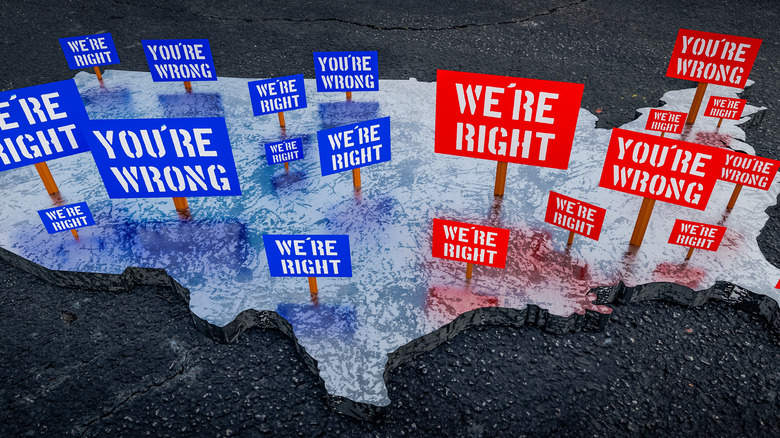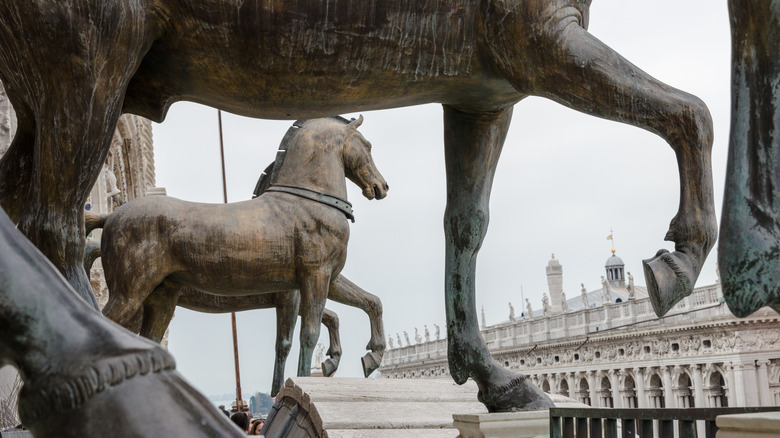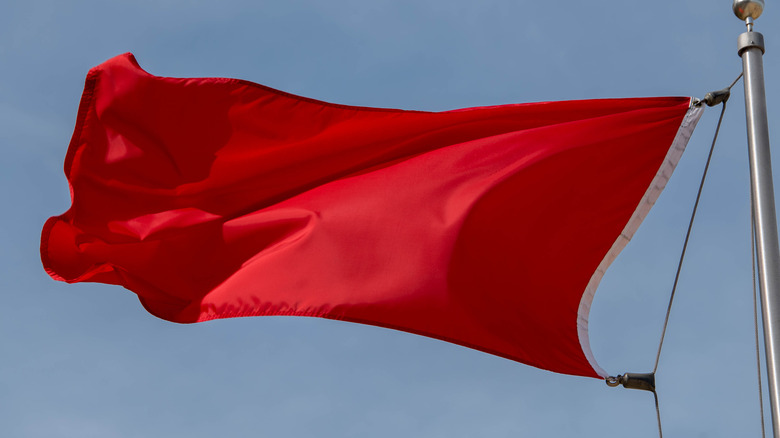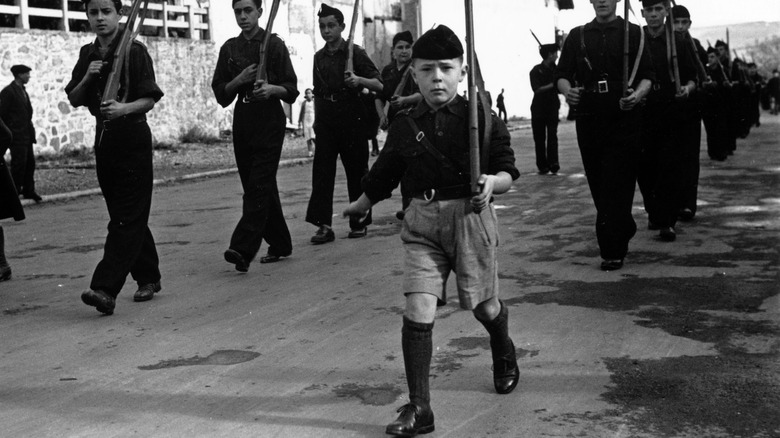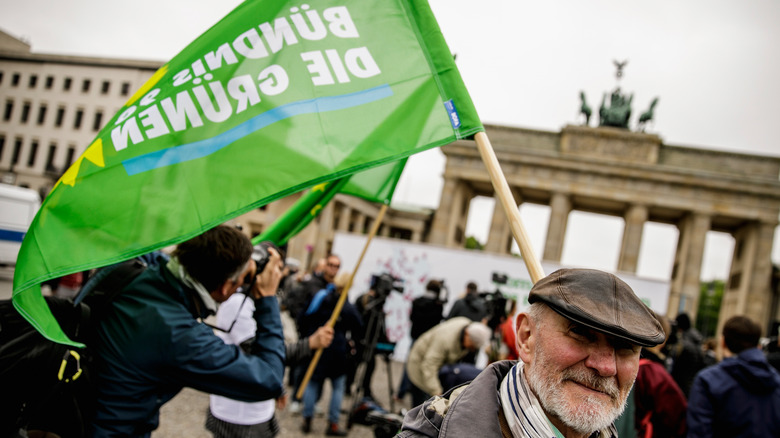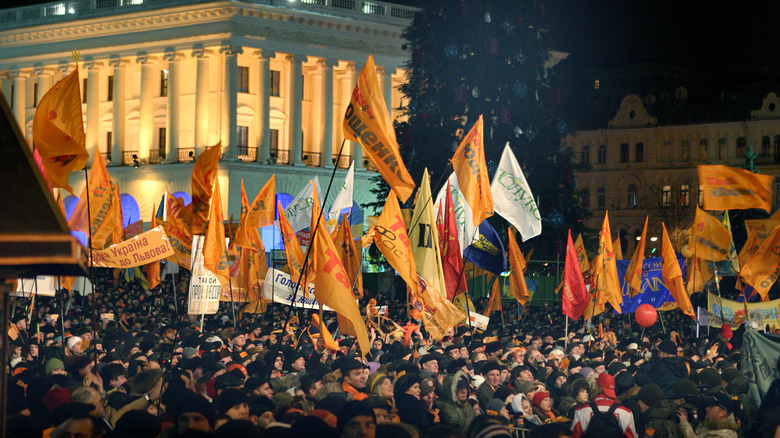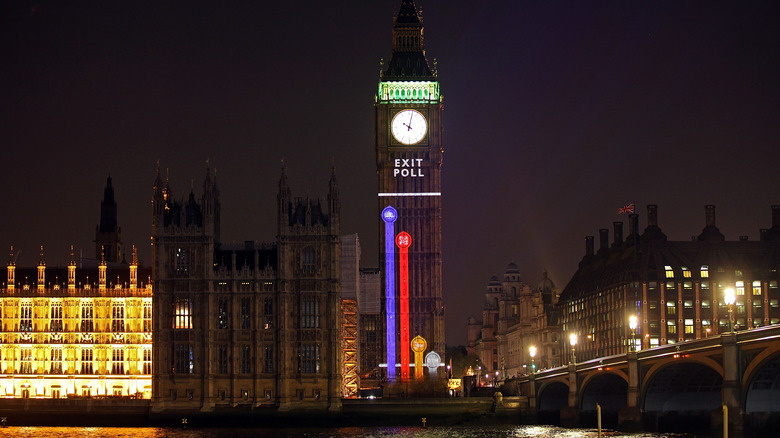Why Did We Start Calling States Red Or Blue?
Red states, blue states. If you're new to U.S. electoral politics, you may not have heard these phrases before. For the past few decades, the color red has been associated with America's center-right Republican Party, while blue is the color of the center-left Democratic Party. You'll hear this distinction most commonly on the night of a national election, when TV news anchors compile the results, state by state: "Illinois is solidly blue, North Carolina might turn red." (A "purple state" is evenly split between Democratic and Republican voters.)
But the red-blue distinction is not just election-news jargon. Red and blue are as closely associated with the two parties as the colors of soccer teams. American presidents often appear in public wearing a tie in the solid color of their particular party. It's hard to imagine Donald Trump not wearing a scarlet tie with his suit, or Barack Obama without cool blue. (This seems to be a male ritual, though. As LiveScience points out, 2016 Democratic candidate Hillary Clinton often wore red.)
The real question, though, is how these colors got to be associated with their party. Was it arbitrary, or is there another meaning?
Team sports, blood sports
Political colors have a much older history than the modern, American iteration. The oldest case of colors being adopted by political parties is about 1,500 years old. In the sixth century, the organized sport of chariot racing inspired the same passions in the Byzantine Empire that soccer inspires today, as Smithsonian explains. The racing teams each had a color, and each attracted fans from a particular class or area. The Blues, for instance, drew fans from the aristocracy; their hated rivals, the Greens, were supported by commoners. The sporting rivalry and the class, religious, and political enmity between the fans was never quite distinguishable. In 520, a fight that broke out in the hippodrome of Constantinople between the Blues and the Greens — ostensibly over the race, but inflamed by tensions around a new tax law — caused a riot that had to be put down by the army. The Emperor Justinian felt, perhaps with reason, that his life was at risk.
Political colors faded in the Middle Ages, when the arms of a particular lord or monarch functioned as political badges, but occasionally factions or parties would adopt a color. This was especially true in the Italian republics, like Florence, where the ruling Guelph faction broke into two camps: the Whites and Blacks (via Britannica). Dante Alighieri, a White, would be exiled by his Black rivals on pain of death, inspiring his great poem of exile and salvation, the Divine Comedy.
The color of revolution
During the French Revolution, the color red began to take on a lasting political significance, particularly in the form of the red flag. The most radical revolutionaries, called the Jacobins, sometimes flew a red flag alongside the patriotic French tricolor; the red symbolized blood, their own and other people's, that the revolutionaries were willing to shed (per Age of Revolution). The color red became a symbol around the world in the first half of the 19th century, not just of revolution, but of youth and its violent romance. The dashing South American officers who fought for independence against Spain occasionally flew a red flag, as did the students on the barricades of Paris in 1848 and striking workers in Wales in 1831.
When working class Parisians seized the city government in 1871, they flew the red flag, inspiring a generation of left-wing radicals to do the same (via History Today). The Bolshevik Revolution on 1917 based the new flag of the Soviet Union on the Paris Commune's red flag; so too would Communist China. "Red" became a synonym of "Communist" well into the 1960s, as in the "Red Scares" of the McCarthy period.
The British Labour Party — which, unlike the U.S. Democratic Party, has its roots in the socialist movement of the early 1900s — is still closely identified with the color red. The official party anthem, as Age of Revolution notes, is actually called "The Red Flag."
White, black, and other reactions
The revolutionary stirrings of the 19th century, and their brutal maturity in the 20th, made the color red and all its implications hateful for many people. The reactionary movements in Europe adopted colors that looked like the opposite of red. In Russia, for instance, the forces loyal to the deposed czar and at war with the revolutionaries became the Whites (via Britannica). The color implied social and religious purity, in contrast with the atheism and strife of Communism.
In Italy, black became the color of reaction, particularly as Benito Mussolini's Fascist Party came to power in 1922. Mussolini's thugs were known as the Blackshirts, from the uniform they wore, which inspired similar far-right militants like the German Nazis and the Falangists of Spain. (Falangist youth in uniform are shown above.) The word black became shorthand for fascism, and later neofascism, in Italian history. In Germany, brown took on a similar meaning; a "beefsteak Nazi" was, as the book "Contending with Hitler" describes, a Nazi with anticapitalist views — brown on the outside, red on the inside.
The greens
One modern political current known only by its color is the Green movement. The color green suggests plant life and, more distantly, ocean water; it's a natural fit for a movement dedicated to protection of the environment. The Green movement began in the 1970s, building on the work of science writers, esoteric nature worshipers like Rudolf Steiner, and the utopian vision of the hippie generation, summed up thus by Britain's Green Party: "No longer can economics, military spending, inequality, agriculture, biodiversity loss, mental health, crime, poverty and so on be treated as separate, independent issues."
The Greens have seen greater success in Northern and Western Europe than anywhere else, as the Council on Foreign Relations underscores. In Germany, they often serve as kingmaker in parliamentary elections, providing parliamentary votes in exchange for policy concessions. (Germany's dependence on Russian natural gas is largely the result of Green opposition to nuclear power.) But in every country, their color has become a byword for their activism.
The color revolutions
As The New York Times reported in 2005, all the political upheavals in the Middle East and post-Soviet world of the early 2000s had their own colors as well. The most famous of these was the Orange Revolution in Ukraine. The movement sprang up in 2004 to protest a rigged presidential election; the color, according to Deutsche Welle, was meant to suggest energy. It was also a powerful visual departure from the red of Ukraine's Communist past, and the light blue palette used on campaign by the election's winner, the Russian-backed Viktor Yanukovych.
The pro-democracy movement in the republic of Georgia was called the Rose Revolution, for the roses that people carried in protest and for the color of passion and youth. A similar stirring in Lebanon was briefly called the Candy Cane Revolution for the red and white scarves its supporters wore. (It eventually got the less frivolous name of the Cedar Revolution, for the tree that symbolizes Lebanon.)
Party colors
In the era of televised news, colors stood in for political parties in graphics on election nights, like the one projected onto Big Ben in London in the image above. The colors assigned a party may or may not have a clear rationale. In the U.K., the Labour Party is always red; the Conservative Party is blue, a calming color that suggests the opposite of red's violent emotions. Other party colors are more or less random, like the purple of the U.K. Independence Party or the yellow of the Scottish National Party (via CNN).
According to a 2012 post by Mental Floss, America's Democrats and Republicans came by their colors in a similarly random way. In 1976, NBC's televised election coverage featured a color-coded map with Republican states in yellow, Democratic states in blue, and uncounted states as red. These colors changed from election to election. But just before the controversial 2000 election of George W. Bush, TV journalist Tim Russert referred to Republican states as "red states." Soon outlets like The New York Times were only running maps with Democratic states in blue and Republican states in red. The practice continues today.
Why did those colors stick? It's hard to say. Symbolically, a color can represent different things to different people. In any event, the colors are now inseparable from their parties.
